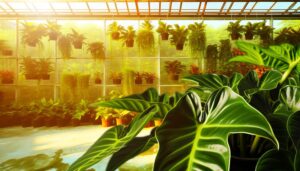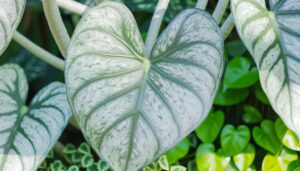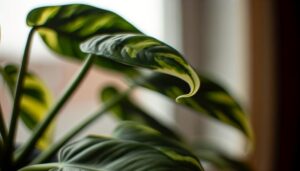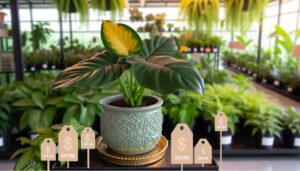What Are Aerial Roots on a Philodendron Brasil?
Philodendron Brasil aerial roots are specialized structures that develop from plant stems above ground. They are integral to climbing and nutrient acquisition, primarily in humid and nutrient-rich environments.
Composed of epidermal cells, cortex, and a vascular cylinder, these elongated fibrous formations exhibit positive phototropism and negative gravitropism. Their primary functions include absorbing moisture and nutrients, providing structural support, and enhancing the plant's adaptability to diverse habitats.
These adaptations aid vertical growth, reduce mechanical stress, and optimize resource uptake. For a detailed understanding of how these roots contribute to the Philodendron Brasil's health and growth, continue exploring.
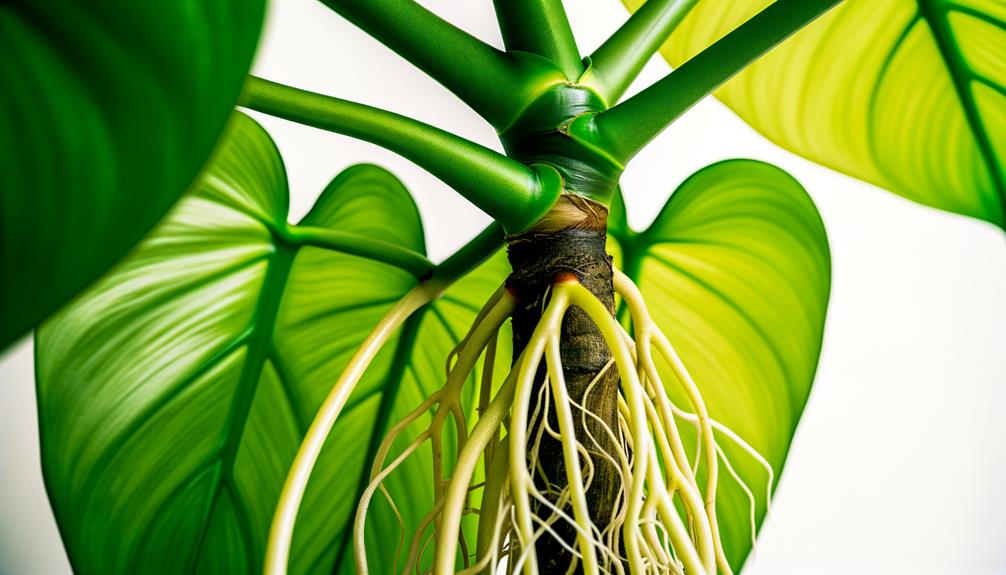
Key Takeaways
- Aerial roots are specialized structures that grow from the stem above ground.
- They provide structural support and help the plant climb for better light exposure.
- Aerial roots absorb moisture and nutrients from the environment.
- They are composed of epidermal cells, cortex, and vascular cylinder, facilitating nutrient absorption and stability.
- Aerial roots are an adaptation to humid, nutrient-rich environments, enhancing the plant's resilience.
Definition of Aerial Roots
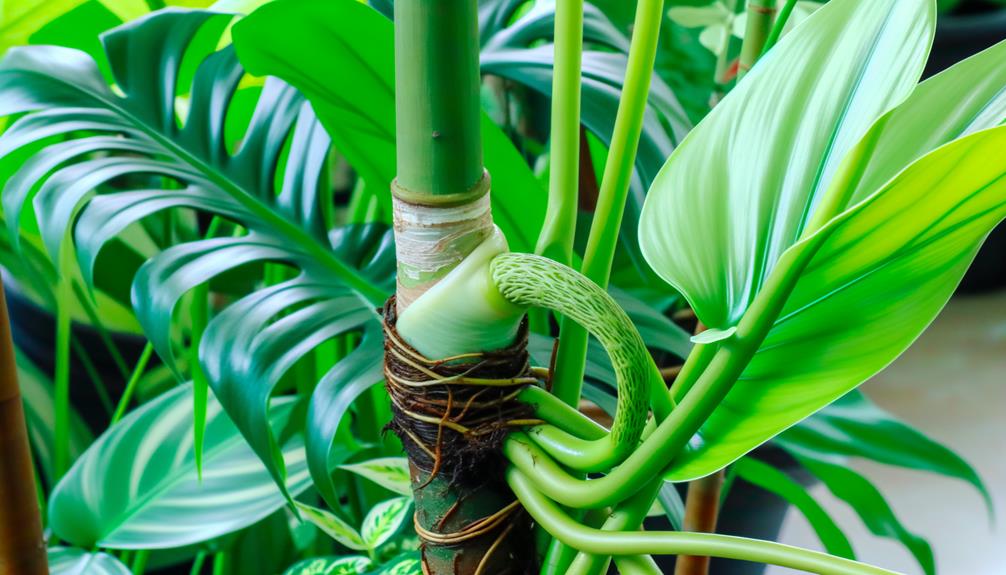
Aerial roots are specialized structures that grow from the stem of a plant above the ground and are primarily involved in the absorption of moisture and nutrients from the air. These roots exhibit unique physiological adaptations, such as velamen, a spongy tissue layer that enhances water and nutrient uptake.
In Philodendron Brasil, aerial roots also facilitate structural support by anchoring the plant to surrounding surfaces. This enables the plant to thrive in its native epiphytic environment, where soil contact is minimal.
Additionally, aerial roots possess a remarkable capacity for gas exchange, contributing to overall plant respiration. Understanding these specialized structures aids in optimizing care strategies, ensuring the Philodendron Brasil's health and growth in both natural and cultivated settings.
Origin of Aerial Roots
The origin of aerial roots in Philodendron Brasil can be attributed to its natural climbing mechanism and environmental adaptation. These roots enable the plant to anchor itself to vertical surfaces, facilitating upward growth and maximizing light exposure.
Additionally, aerial roots serve as a physiological adaptation to humid and nutrient-rich environments, allowing the plant to absorb moisture and essential nutrients directly from the atmosphere and substrate.
Natural Climbing Mechanism
Philodendron Brasil exhibits a specialized adaptation through its development of aerial roots, which facilitate its natural climbing mechanism by anchoring the plant to surrounding surfaces and absorbing moisture and nutrients from the air. These roots emerge from the plant's nodes and are characterized by their spongy, fibrous texture, enabling efficient attachment to substrates such as tree bark and moss.
This epiphytic strategy allows the Philodendron Brasil to ascend vertical supports, optimizing its exposure to sunlight while reducing competition for ground resources. The aerial roots contain specialized cells, known as velamen, which enhance water retention and nutrient absorption from the atmosphere. This climbing mechanism is a critical evolutionary trait, allowing the Philodendron Brasil to thrive in diverse habitats.
Adaptation to Environment
Understanding the origin of aerial roots in Philodendron Brasil requires examining the plant's adaptation to its native tropical environments, where these specialized structures evolved to optimize survival and resource acquisition.
In these humid, dense forests, sunlight and soil nutrients are often limited. Aerial roots enable Philodendron Brasil to climb vertical surfaces, such as tree trunks, thereby accessing higher light levels. These roots also absorb moisture and nutrients directly from the air and organic debris, bypassing the competition at the forest floor.
Morphologically, the aerial roots are equipped with specialized cells that facilitate water and nutrient uptake, enhancing the plant's adaptability. This evolutionary trait confers a significant survival advantage, illustrating the intricate interplay between environmental pressures and morphological developments.
Structure and Appearance
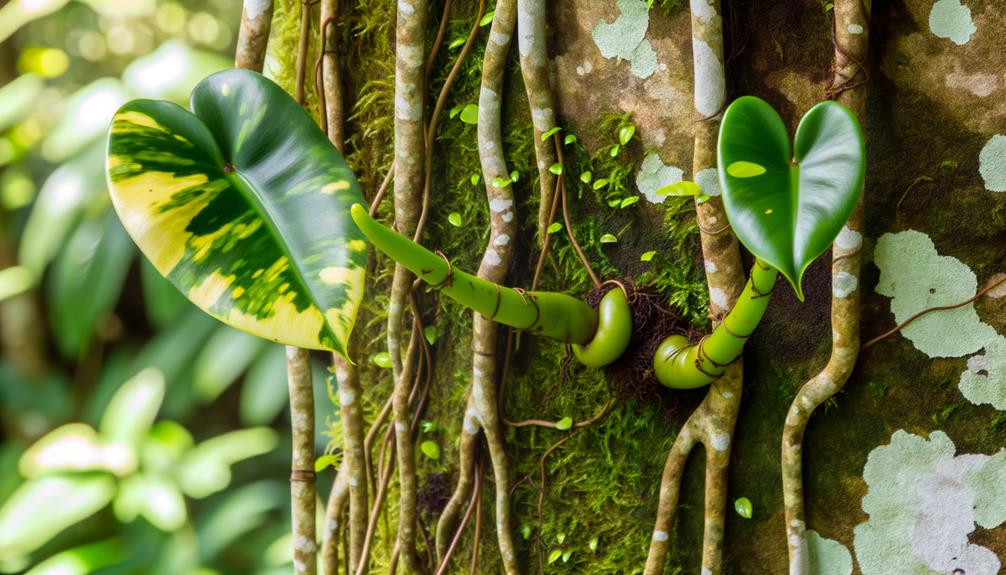
Exhibiting a complex morphology, the aerial roots of a Philodendron Brasil are characterized by their elongated, fibrous structures that extend from the stem nodes and function primarily in anchorage and nutrient absorption.
These roots, often brown or greenish-brown, possess a rough texture due to the presence of root hairs, which increase surface area for efficient nutrient uptake.
Microscopically, the aerial roots are composed of an outer layer of epidermal cells, a cortex rich in parenchyma, and a central vascular cylinder.
Morphogenetically, they display positive phototropism initially, aligning towards light sources before demonstrating negative gravitropism, aiding in their anchoring capability.
This dual tropistic behavior underlines their evolutionary adaptation to variable environmental niches, ensuring both structural stability and resource acquisition.
Main Functions
Aerial roots on a Philodendron Brasil mainly aid in absorbing nutrients from organic matter in the environment, enhancing the plant's nutritional intake.
In addition, these roots help provide structural support by anchoring the plant to different surfaces, thereby promoting vertical growth.
Their moisture intake process also enables the plant to efficiently absorb water from the surrounding air, ensuring hydration even in less ideal soil conditions.
Nutrient Absorption Mechanism
The nutrient absorption mechanism of Philodendron Brasil's aerial roots primarily involves the uptake of water and essential minerals directly from the surrounding environment, facilitating efficient nutrient transport throughout the plant's vascular system.
These specialized roots contain numerous trichomes and root hairs that increase the surface area for absorption. The presence of hydrophilic substances in the cell walls aids in the rapid uptake of moisture and dissolved ions.
Additionally, these roots can secrete enzymes that break down organic matter, making nutrients more accessible. The absorbed nutrients are then translocated via the xylem and phloem to various parts of the plant, ensuring best growth and physiological function.
This intricate process underscores the adaptability and resilience of Philodendron Brasil in diverse habitats.
Structural Support Role
Beyond their role in nutrient absorption, the aerial roots of Philodendron Brasil also contribute greatly to the plant's structural support, anchoring it effectively to various surfaces and substrates. These roots exhibit a robust morphology, characterized by their ability to adhere to vertical supports like tree trunks or artificial structures.
This adhesion process involves the secretion of adhesive compounds, facilitating a firm attachment that stabilizes the plant as it ascends. The mechanical strength of these roots is critical for distributing the plant's weight, preventing toppling, and ensuring the plant's exposure to light is at its best.
Moreover, the aerial roots' structural integrity allows Philodendron Brasil to expand its growth habitat, enhancing its adaptability and resilience in both natural and cultivated environments.
Moisture Intake Process
Regularly contributing to the Philodendron Brasil's hydration, the aerial roots efficiently absorb moisture from the surrounding environment through specialized epidermal cells designed for this purpose. These cells, known as trichoblasts, facilitate the uptake of water vapor and atmospheric humidity, which is then translocated to the main plant body.
This process is especially important in epiphytic habitats where soil moisture is scarce. The hygroscopic properties of these roots allow the plant to sustain its physiological functions and maintain turgor pressure. Additionally, the presence of hydrophilic mucilage on the root surface enhances water retention, optimizing the plant's ability to harness ambient moisture.
Therefore, aerial roots play a significant role in the Philodendron Brasil's adaptability and survival in diverse environmental conditions.
Support and Stability
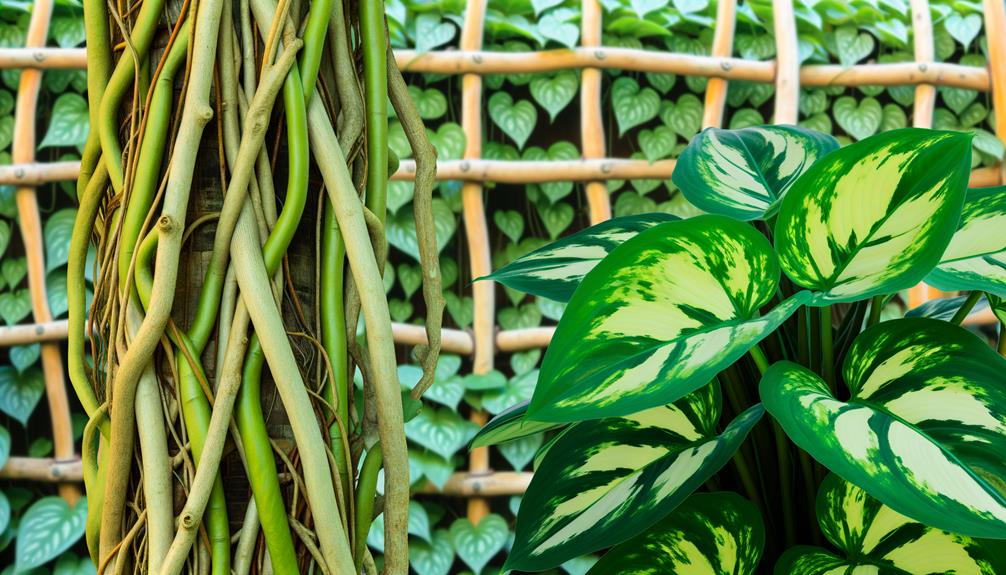
Aerial roots on a Philodendron Brasil play an important role in providing structural support and enhancing overall plant stability. These specialized roots anchor the plant to various surfaces, allowing it to climb and maintain an upright growth habit. By attaching to vertical structures, aerial roots reduce mechanical stress on the stem, mitigating the risk of breakage. This adaptive characteristic is particularly advantageous in their native tropical habitats, where competition for light necessitates vertical growth.
| Function | Description |
|---|---|
| Structural Support | Anchors plant to surfaces, aiding in vertical growth |
| Stability | Reduces mechanical stress on stem |
| Climatic Adaptation | Enables better light acquisition in dense forests |
| Risk Mitigation | Prevents breakage by distributing weight |
Such mechanisms guarantee the Philodendron Brasil's resilience and longevity in diverse environmental conditions.
Nutrient Absorption
In addition to providing structural support, aerial roots of the Philodendron Brasil play an important role in the absorption of necessary nutrients and moisture from the surrounding environment.
These specialized roots display a remarkable ability to uptake atmospheric humidity and dissolved minerals, functioning similarly to traditional terrestrial roots. Microscopic root hairs increase the surface area, enhancing absorptive efficiency.
This adaptation allows the Philodendron Brasil to thrive in nutrient-poor substrates by capturing nutrients from rain, mist, and organic debris. The presence of lignin and suberin in the root structure aids in minimizing water loss while facilitating nutrient intake.
Consequently, aerial roots contribute significantly to the plant's overall nutrient acquisition strategy, ensuring sustained growth and health in diverse habitats.
Environmental Adaptations
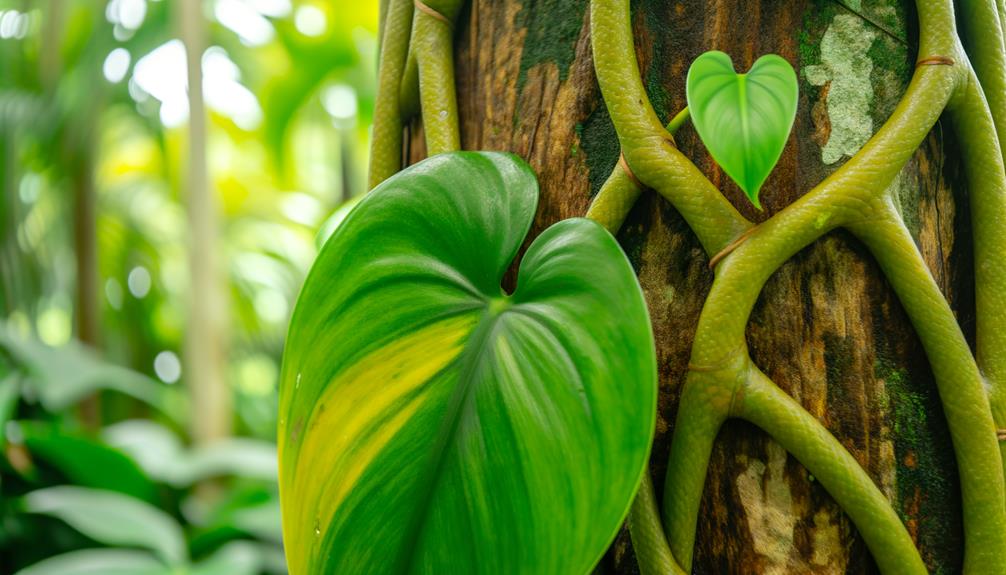
Philodendron Brasil displays a variety of environmental adaptations, including the development of specialized aerial roots, which enable it to thrive in diverse ecological niches. These adaptations facilitate resource acquisition and structural support, maximizing survival in variable conditions.
- Epiphytic Growth: Aerial roots allow the plant to anchor onto other structures, improving access to light and air.
- Hydroscopic Properties: These roots can absorb moisture directly from the atmosphere, essential in humid environments.
- Nutrient Foraging: Aerial roots can extend to reach nutrient-rich substrates, compensating for poor soil conditions.
- Gas Exchange: Enhanced aeration through aerial roots aids in efficient respiration.
- Climbing Mechanism: These roots provide mechanical support, allowing the plant to ascend towards best light sources.
These adaptations collectively contribute to the Philodendron Brasil's ecological versatility and resilience.
Growth Conditions
To achieve peak growth and development of Philodendron Brasil's aerial roots, it is essential to maintain specific environmental parameters. These include providing sufficient light intensity, ensuring suitable humidity levels, and moisture availability, and utilizing well-draining soil with balanced fertilization.
Each of these factors plays a key role in the physiological health and morphological characteristics of the plant.
Optimal Light Requirements
Best light conditions for Philodendron Brasil require exposure to bright, indirect sunlight to promote vigorous growth and prevent etiolation. Proper light conditions are essential for maximizing photosynthetic efficiency and meeting the plant's energy needs.
Direct sunlight can cause photodamage to the foliage, leading to chlorosis and necrosis. Conversely, insufficient light can result in leggy growth and poor overall health.
- Light Intensity: 10,000 to 20,000 lux is ideal.
- Duration: 12-14 hours of light exposure daily.
- Light Source: Fluorescent grow lights can complement natural light.
- Placement: Near east or north-facing windows.
- Signs of Inadequate Light: Pale leaves, elongated stems.
Such conditions not only support robust growth but also promote the development of healthy aerial roots.
Humidity and Moisture Needs
Maintaining ideal moisture and humidity levels is crucial for the physiological and morphological health of Philodendron Brasil. This requires an environment with relative humidity between 60% and 80% and consistent, moderate watering practices.
Elevated humidity supports efficient transpiration and nutrient uptake, promoting strong growth and the development of aerial roots. Inadequate humidity levels can lead to desiccation, reduced vigor, and impaired photosynthetic efficiency.
Watering should be uniform, guaranteeing the substrate remains moist but not waterlogged, to prevent root rot and other pathologies. Using hygrometers to monitor ambient humidity and employing humidifiers or pebble trays can optimize conditions.
These practices ensure the maintenance of homeostasis, facilitating the plant's normal physiological processes and enhancing its overall health.
Soil and Fertilization
Ideal soil structure and precise fertilization practices are necessary for the strong growth and health of Philodendron Brasil. A well-aerated, fast-draining substrate is pivotal to prevent root rot and promote nutrient absorption. The soil should retain moisture without becoming waterlogged, ensuring an excellent root environment.
Fertilization must be balanced, providing macro and micronutrients necessary for vigorous growth.
- Soil Structure: Use a blend of peat, perlite, and orchid bark for optimal drainage and aeration.
- pH Levels: Maintain a slightly acidic to neutral pH range of 5.5 to 7.0.
- Nutrient Requirements: Apply a balanced, water-soluble fertilizer with a ratio of 20-20-20.
- Frequency: Fertilize bi-monthly during the growing season (spring and summer).
- Organic Matter: Incorporate compost or worm castings to enhance soil fertility.
Care Tips
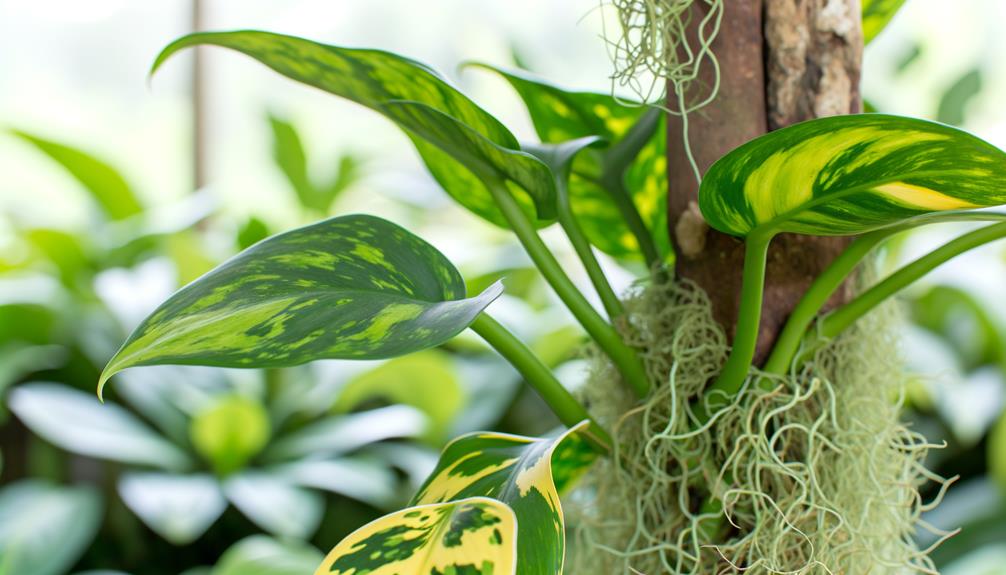
To achieve best growth and health of a Philodendron Brasil, it is essential to understand and implement specific care practices tailored to its unique physiological needs.
Optimal lighting is crucial; provide bright, indirect light to prevent chlorosis while avoiding direct sunlight that can cause photodamage.
Maintain ambient temperatures between 65-80°F and relative humidity levels above 60% to support foliar and aerial root development.
Watering should be consistent but not excessive, ensuring the substrate is evenly moist but not waterlogged to mitigate root rot.
Fertilize bi-monthly with a balanced, water-soluble fertilizer during the growing season to sustain nutrient uptake.
Regular pruning of leggy stems encourages robust growth and prevents etiolation, while periodic cleaning of leaves enhances photosynthetic efficiency.
Benefits to the Plant
Aerial roots on a Philodendron Brasil confer numerous physiological advantages, including enhanced nutrient and water absorption, increased structural stability, and improved adaptability to varying environmental conditions.
These specialized roots contribute significantly to the plant's vitality through various mechanisms:
- Nutrient Uptake: Aerial roots can absorb nutrients directly from the air and surrounding debris, supplementing soil intake.
- Water Absorption: These roots capture moisture from the atmosphere, aiding in hydration during dry periods.
- Anchorage: They provide additional support by anchoring the plant to surfaces, reducing the risk of toppling.
- Climbing: Facilitating vertical growth, aerial roots enable the plant to climb, optimizing light exposure.
- Environmental Adaptation: They allow the plant to thrive in diverse habitats by adjusting root functions based on environmental stimuli.
This multifaceted functionality emphasizes the evolutionary advantages of aerial roots in Philodendron Brasil.
Common Issues
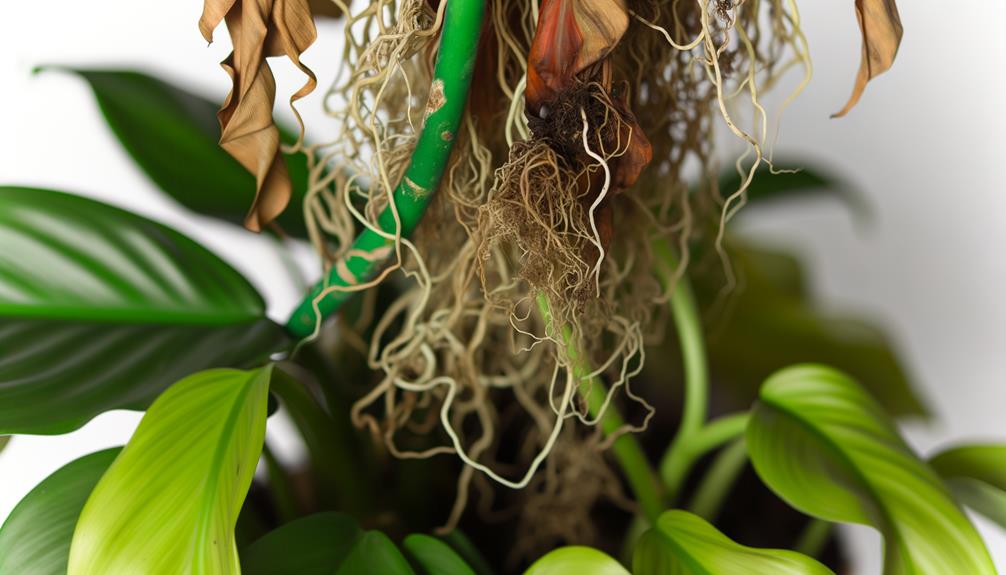
Common issues linked with aerial roots on a Philodendron Brasil include root desiccation, pest infestations, and structural damage due to environmental stressors.
Root desiccation occurs when aerial roots are exposed to low humidity or insufficient watering, leading to dehydration and compromised functionality.
Pest infestations, like spider mites and scale insects, can target aerial roots, causing harmful effects on overall plant health.
Structural damage arises from environmental stressors such as strong winds or physical disturbances, which can break or weaken the roots.
These issues require attentive care and monitoring to guarantee the aerial roots remain healthy and robust, thereby sustaining the physiological benefits they provide to the Philodendron Brasil.
Regular inspection and appropriate environmental adjustments are vital in mitigating these challenges.
Propagation Methods
Propagation of Philodendron Brasil can be effectively achieved through stem cuttings, which, when properly executed, allow for the successful development of new plants. This vegetative propagation method leverages the plant's natural ability to generate roots at nodes. Critical steps include selecting a healthy stem with at least one node and aerial root, ensuring a clean cut, and placing the cutting in an appropriate growing medium.
Key considerations for successful propagation include:
- Sterilizing cutting tools to prevent pathogen transmission.
- Using rooting hormone to enhance root development.
- Maintaining high humidity levels to support initial growth.
- Ensuring adequate light without direct sunlight to prevent damage.
- Monitoring for pests and diseases that can inhibit growth.
These steps optimize the conditions for root initiation and plantlet development.
Conclusion
To sum up, aerial roots on a Philodendron Brasil serve as the plant's lifelines, anchoring it to its environment and ensuring access to essential nutrients and moisture.
These roots, with their unique structure and multifaceted functions, embody the plant's adaptability and resilience.
Like the tendrils of a climber scaling a wall, aerial roots provide both support and sustenance, illustrating the intricate and symbiotic relationship between the Philodendron Brasil and its surroundings.
Proper care and understanding of these roots are crucial for best plant health.

